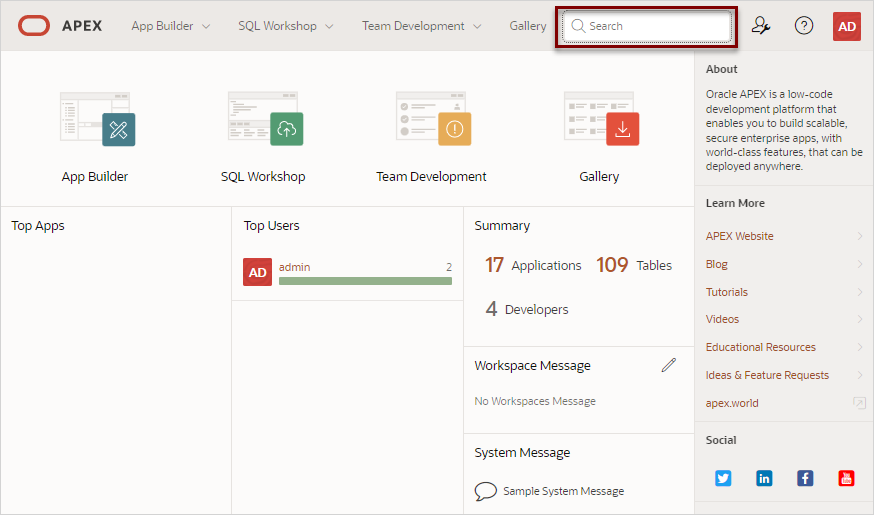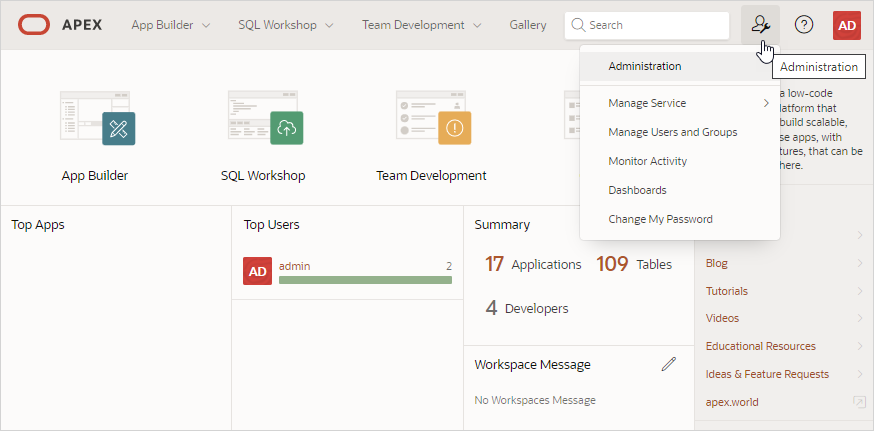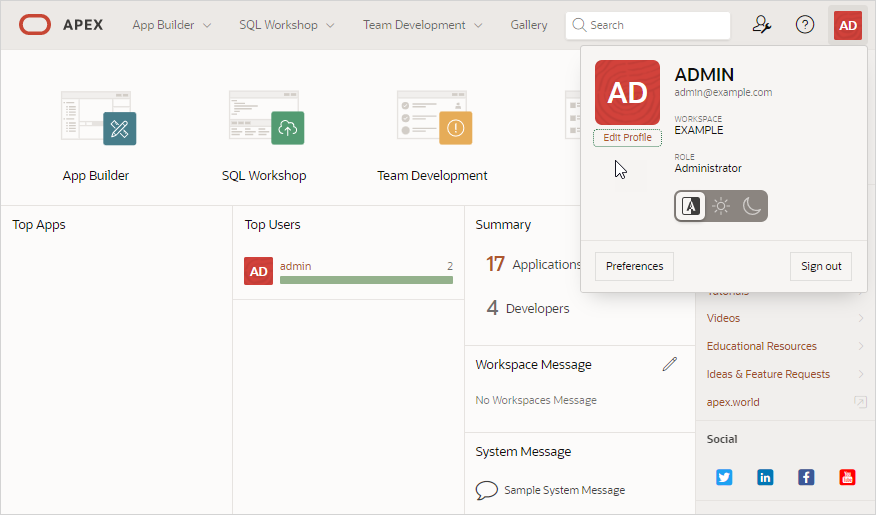2.4 Developer Navigation Tools
Developer Navigation tools display in the header region on many Oracle APEX pages, including the Workspace home page, App Builder home page, the Application home page, Page Designer, and Shared Components.
- Global Search
Use Global Search to navigate App Builder. - Administration Menu
Click the Administration menu to access Workspace Administration pages such as Manage Service, Manage Users and Groups, Monitor Activity, Dashboards, or to change your password. - Help Menu
Click the Help menu to link to documentation on Oracle Help Center, the Discussion Form, the Oracle APEX page, and the About Oracle APEX dialog. - Account Menu
Click the Account menu to configure appearance settings, edit your user profile or preferences, or sign out.
Parent topic: Quick Start
2.4.1 Global Search
Use Global Search to navigate App Builder.
The Global Search field (also known as Spotlight Search) displays in the header region.
Key features of Global Search include:
-
Offers effortless navigation within a workspace enabling you to quickly find applications, pages, Shared Components, APEX menus, and so on.
-
Search for component names and immediately set focus to those items in Page Designer.
-
Provides a unified search experience throughout APEX.
About Using Global Search
You can activate Global Search in two ways:
-
Click the Global Search field in the in the header region
-
Use the keyboard shortcut (
Ctrl + Quote) (') (US Keyboards only)
Use Global Search to search all applications in the workspace no matter what your location in the current workspace. For example, if your workspace contains the Sample Reporting sample app, entering Sample will find it. Similarly, you can access global navigation menus that appear at the top window adjacent to the Oracle logo. For example, enter SQL Commands in the Global Search field to instant access SQL Commands.
To close the Global Search dialog, press the Esc key, or click anywhere outside the results.
Syntax to Navigate to a Page or Search for a Regular Expression
Search by page name and page alias. With in an in-app, use a colon (:) or dash (–) between the application ID or alias and the page ID, name, or alias.
Within App Builder and on the Application home page, use the following syntax to navigate to a specific page or search for a regular expression:
page_ID
page_NAME
page_ALIAS
application_ID:page_ID
application_NAME:page_ID
application_ALIAS:page_ID
application_ID-page_ID
application_NAME-page_ID
application_ALIAS-page_ID
regexp:expression
Where:
-
page_ID- Numeric identification number (or ID) that identifies a specific page. -
page_NAME- An alphanumeric name that identifies a specific page. -
page_ALIAS- An alternate alphanumeric page identifier. You can use this identifier in place of the page name. -
application_ID- A numeric identification number (or ID) that identifies an application. -
application_NAME- The alphanumeric name that identifies an application. -
application_ALIAS- An alternate alphanumeric application identifier. You can use this identifier in place of the application name. -
regexp:- Is literal text. -
expression- Is a regular expression to search for.
You can replace page_ID for page_NAME
orpage_ALIAS when searching by
application_ID or
application_ALIAS.
The following example navigates you to page 10 of application 570:
10 570-10 570:10
You can also use this syntax to navigate to the Shared Components page of a given application:
application_ID:s application_ID-s
Where:
-
application_IDis the numeric identification number (or ID) that identifies an application.
The following example demonstrates how to navigate to the Shared Components page of application 570:
570:s 570-s
About Navigating Search Results
Global Search results display in a dialog. Use the Up and Down arrows keys to navigate the results and press Enter to make a selection. Since the the Global Search icon displays on nearly every page in APEX, you can continue to narrow your search until you find the app, page, or component (such as the item, button, or region) which contains the keyword.
Other available shortcuts change depending on where you are in App Builder, for example:
-
In Page Designer - To search for a page, press
Ctrl + 4. -
In App - To search within an application, press
Ctrl + 3. -
All Apps - To search all applications, press
Ctrl + 2. -
Current Workspace - To search a workspace, press
Ctrl + 1.
Tip:
Some browsers map theseCtrl key shortcuts for quick tab navigation. In that case, the
shortcut does not work as described above. Instead, they simply activate a
particular open browser tab.
Example 2-1 Search Example
Suppose you need to find an application called Employees which includes
interactive grid built on the EMP table.
-
Find the application.
-
On the Workspace home page, click the Global Search field and enter emp.
Global Search would return the results:
-
Employees (App)
-
Templates
-
Create Email Template
-
Search all applications for emp (
Ctrl + 2) -
Search Workspace for emp (
Ctrl + 1)
Note:
Templates and Create Email Template appear because they contain the text stringemp. -
-
Select Employees to view that application.
The Employees application appears.
-
-
Search the application.
-
On the Application home page, click the Global Search field and enter EMP.
Global Search returns the results that include numerous pages and other items.
-
Select the option the includes a page reference.
The page appears in Page Designer.
-
-
Search the page.
-
In Page Designer, find the Global Search field and enter EMP again.
Global Search returns the results that include numerous components.
-
Select a component (such as a process, column, region, and so on).
-
Parent topic: Developer Navigation Tools
2.4.2 Administration Menu
Click the Administration menu to access Workspace Administration pages such as Manage Service, Manage Users and Groups, Monitor Activity, Dashboards, or to change your password.
The Administration menu displays to the right of the Global Search field and features an outline person with a wrench.
Clicking the Administration menu displays the following options:
-
Administration links to the Workspace Administration page. To access the Oracle APEX development environment, users sign in to a shared work area called a workspace. Workspace administrators monitor and administer a workspace. Common workspace administration tasks include managing service requests, configuring workspace preferences, creating workspace announcements, managing session state, creating user accounts, and managing groups. See Workspace Administration Page in Oracle APEX Administration Guide.
-
Manage Service displays a submenu of options on the Manage Service page. Administrators use the Manage Service page to manage service requests, configure workspace preferences, define workspace messages, enable a workspace-level banner, view the Workspace Summary report, and configure Extension menu links. See Manage Service Page in Oracle APEX Administration Guide.
-
Manage Users and Groups links to Manage Users and Groups page. Workspace administrators can create new user accounts, manage existing user accounts, and change user passwords. See Managing Users in a Workspace in Oracle APEX Administration Guide.
-
Monitory Activity links to the Monitor Activity page. Use this page to monitor changes to page views, developer activity, page view analysis, and active sessions. It also shows reports on such information as login attempts and external click counts. See Monitoring Activity Within a Workspace in Oracle APEX Administration Guide.
-
Dashboards links to the Dashboard page. Use this page to view details about the current workspace and monitor users, activity, developer activity, performance, application development, and view database details. See Viewing Workspace Dashboards in Oracle APEX Administration Guide.
-
Change My Password links to the Change Password section of the Edit Profile dialog box. See Changing Your Profile or Password.
Parent topic: Developer Navigation Tools
2.4.3 Help Menu
Click the Help menu to link to documentation on Oracle Help Center, the Discussion Form, the Oracle APEX page, and the About Oracle APEX dialog.
The Help menu resembles a question mark enclosed with a circle.
Click the Help menu to access the following menu items:
-
Documentation links to Oracle APEX, Oracle Help Center.
-
Discussion Forum links to the Categories page where you can access APEX Discussions.
-
Learn More about Oracle APEX links to the Oracle APEX page.
-
About. Links to the About Oracle APEX dialog. This dialog includes information about the APEX instance and the database version, including the APEX release number, workspace name, environment details, and database information. See Viewing Product Release and Environment Information in Oracle APEX Administration Guide.
See Also:
Parent topic: Developer Navigation Tools
2.4.4 Account Menu
Click the Account menu to configure appearance settings, edit your user profile or preferences, or sign out.
The Account menu displays in the upper right corner of the page. Open the Account menu by clicking on the User icon in the header.
The Account menu displays your username, email address, the current workspace, and your user role. If Single Sign On (SSO) is enabled, the link Change Workspace also appears.
Tip:
If you are using Single Sign-on authentication, Change Workspace also displays. Click Change Workspace to view a list of workspaces you have access to.
Key controls on Account menu include:
- Edit Profile. Click Edit Profile to
edit the options. Click Apply Changes to save your
changes.
- Profile Details:
- Email Address - Specifies the email address for use with general correspondence, notifications about resetting passwords, and so on.
- First Name - Specify the first or given name to further identify the user. This optional field is used for informational purposes only.
- Last Name - Specify the last or family name to further identify the user. This optional field is used for informational purposes only.
- Profile Photo - Select a photo to further identify the user. This optional field is used for informational purposes only.
- Password - If you wish to change your password, enter a new
password. Otherwise, leave the password fields empty and the current
password will not be changed.
- Enter Current Password - Enter your current password. Do not enter a password unless you want to change the current password.
- Enter New Password - The password used to log in to the system. Do not enter a password unless you want to change the current password.
- Confirm Password - Enter the password again. Do not enter a password unless you want to change the current password.
- Profile Details:
- Appearance. Configure how the Oracle APEX user interface displays. Options include:
- Automatic (default) detects the appropriate setting based on existing system or browser settings.
- Light Mode renders the user interface using dark-colored text, icons, and graphical user interface elements on a lighter background.
- Dark Mode renders the user interface using light-colored text, icons, and graphical user interface elements on a darker background.
- Preferences. Click Preferences to configure the
options. Click Apply Changes to save your changes.
- Default Scheme - Specifies the default schema used for data browsing, application creation, and SQL script execution.
- Default Date Format - Specify the default Oracle date format for the user. This option controls the default date format within SQL Workshop.
- Unicode CSV Downloads - Specify whether to provide SQL Workshop CSV downloads in Unicode. This only affects SQL Workshop and not custom applications.
- Run application in new window - Specify how Oracle APEX manages windows or tabs when running applications from the App Builder when using Mozilla Firefox and Microsoft Internet Explorer.
- Use single window to run all applications - Specify whether different applications reuse the same application runtime window or tab.
- Sign Out. Click Sign Out to log out of the current workspace.




